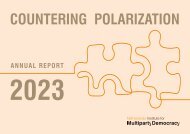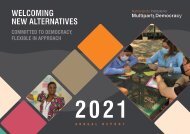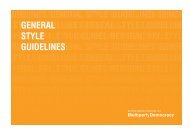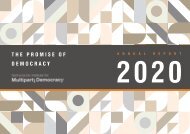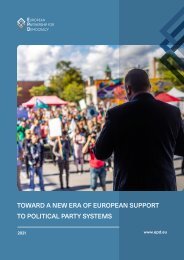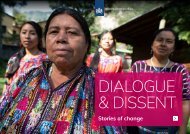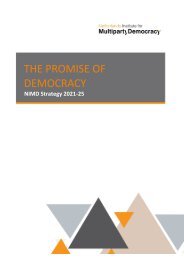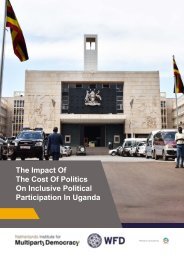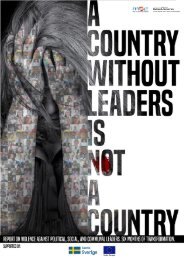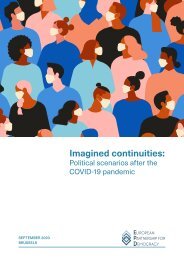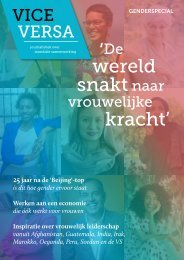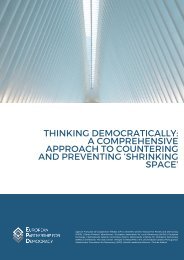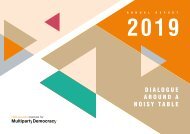Repression and resilience: Diagnosing closing space mid-pandemic
You also want an ePaper? Increase the reach of your titles
YUMPU automatically turns print PDFs into web optimized ePapers that Google loves.
22 REPRESSION AND RESILIENCE: DIAGNOSING CLOSING SPACE MID-PANDEMIC<br />
as well as vulnerable <strong>and</strong> underrepresented groups in<br />
the recovery process. Policies will only effectively meet<br />
the needs of all citizens, if women <strong>and</strong> minorities are<br />
not simply given ‘a seat at the table’, but the majority<br />
voice in governmental decision-making processes<br />
<strong>and</strong> consultations, with real consequences for their<br />
proposals. If p<strong>and</strong>emic recovery will be geared at<br />
rebuilding the problematic status quo of exclusion <strong>and</strong><br />
inequality, the deepened societal inequalities <strong>and</strong> socioeconomic<br />
setbacks of women will be further reinforced. If<br />
restrictions in democratic <strong>space</strong> continue intermittently,<br />
women, minorities <strong>and</strong> underrepresented groups will<br />
similarly continue to be disproportionately affected.<br />
Increased socio-economic inequalities<br />
In line with the previous section on the p<strong>and</strong>emic’s<br />
discriminatory impact on women <strong>and</strong> disadvantaged<br />
populations, the socio-economic implications of the<br />
COVID-19 p<strong>and</strong>emic have been felt most by those<br />
already suffering from inequalities, including economic<br />
inequalities <strong>and</strong> inequalities in access to healthcare,<br />
education <strong>and</strong> internet. While social distancing measures<br />
like teleworking <strong>and</strong> online distance schooling became<br />
the norm, both working from home <strong>and</strong> access to<br />
internet <strong>and</strong> digital tools were a privilege accessible only<br />
to the few. In Latin America, a massive job loss of 68% of<br />
low income jobs was reported, which was not the case<br />
for high income jobs. 65 In Colombia, the unemployment<br />
rate in September was the highest rate since 2001 <strong>and</strong><br />
the unemployment rate for women stood at a record of<br />
26.2%.<br />
This trend is global <strong>and</strong> is confirmed by a number of<br />
studies. International organisations - such as the UN,<br />
the World Bank 66 , the International Monetary Fund 67 -,<br />
internationally renowned economists 68 , <strong>and</strong> NGOs such as<br />
World Vision International 69 , Transparency International 70<br />
<strong>and</strong> Human Rights Watch 71 have all reported on<br />
the negative impact of the p<strong>and</strong>emic on social <strong>and</strong><br />
economic inequalities, especially in developing countries.<br />
According to a report recently released by Oxfam 72 ,<br />
<strong>and</strong> supported by a survey of 295 economists from 79<br />
countries, the p<strong>and</strong>emic threatens to raise inequality in<br />
an unprecedented way in almost every country.<br />
As expected, recent studies confirmed that the p<strong>and</strong>emic<br />
disproportionately affects the poor <strong>and</strong> more vulnerable<br />
groups by showing that social determinants of health—<br />
that is, income, physical environment, gender, age <strong>and</strong><br />
ethnicity - have a considerable impact on COVID-19<br />
outcomes. 73 74 In addition, the lack of or poor access<br />
to drinking water <strong>and</strong> sanitation, or lack of adequate<br />
housing made it far more difficult for the most vulnerable<br />
populations to take the basic precautions against<br />
contracting the disease, as exemplified by the situation<br />
of refugee camps <strong>and</strong> Roma settlements described<br />
65 See Colombia case study.<br />
66 International Monetary Fund & World Bank (2020): “Enhancing access to opportunities”. Available here.<br />
67 Ibid.<br />
68 Stiglitz, J. (2020): “Conquering the Great Divide : The p<strong>and</strong>emic has laid bare deep divisions, but it’s not too late to change course”. Available<br />
here.<br />
69 World Vision (2020): “Policy brief: COVID-19 & Poverty <strong>and</strong> Hunger”. Available here.<br />
70 Transparency International (2020): “For a more equal world post-COVID-19: Focus on the financial gatekeepers”. Available here.<br />
71 Human Rights Watch (2020): “The Other P<strong>and</strong>emic: Fighting Inequality as We Beat Back COVID”. Available here.<br />
72 Oxfam International (2021): “The inequality virus: Bringing together a world torn apart by coronavirus through a fair, just <strong>and</strong> sustainable<br />
economy”. Available here.<br />
73 Abrams, E. & Szefler, S. (2020): “COVID-19 <strong>and</strong> the impact of social determinants of health”. The Lancet Respiratory Medicine, 8(7): 659-<br />
661. DOI:10.1016/S2213-2600(20)30234-4.<br />
74 Burström, B. & Tao, J. (2020): “Social determinants of health <strong>and</strong> inequalities in COVID-19”. European Journal of Public Health, 1;30(4):<br />
617-618. DOI:10.1093/eurpub/ckaa095.




